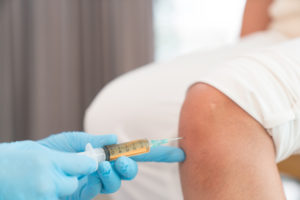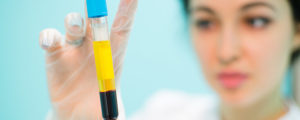Platelet-Rich Plasma (PRP) Injections
What are PRP injections?
PRP stands for platelet-rich plasma. Plasma is the liquid portion of whole blood. It is composed largely of water and proteins, and it provides a medium for red blood cells, white blood cells and platelets to circulate through the body. Platelets, also called thrombocytes, are blood cells that cause blood clots and other necessary growth healing functions.
Platelet activation plays a key role in the body’s natural healing process.
PRP Enhances Healing
Platelet-rich plasma has been found to significantly enhance the healing process, and using a PRP injection for shoulder pain caused by rotator cuff tears, for Achilles tendon ruptures and for other soft-tissue injuries is becoming more common.
PRP has also been demonstrated to improve function and reduce pain in people who have tendonitis or chronic tendinosis conditions such as tennis elbow or golfer's elbow.
PRP Advantages
Some of the key advantages of PRP injections are that they can reduce the need for anti-inflammatories or stronger medications like opioids. In addition, the side effects of PRP injections are very limited because, since the injections are created from your own blood, your body will not reject or react negatively to them. Learn more about PRP injections from the articles and other content below, or select Treating Physicians to find a doctor who provides PRP injection treatment.

What is PRP Therapy and what is Platelet Rich Plasma treatment?
PRP therapy is the process of undergoing a series of Platelet Rich Plasma treatments. Platelet Rich Plasma injections are a newer treatment modality to manage many kinds of orthopedic conditions. The platelets reduce inflammation and accelerate healing by releasing granules which contain growth factors. Normal blood only contains 6% platelets, but platelet rich plasma has significantly more platelets as the name implies. The way plasma is enriched with platelets is by drawing about 10 ml of blood from the patient, then it’s spun at high speeds to separate the platelets from other components in the blood. The separation process takes approximately 10 minutes, then the platelet rich part is taken out. Some local anesthetic is applied to the injured area, and then PRP is injected under ultrasound guidance. The enriched plasma starts going to work and leads to reduced pain and accelerated healing. The entire process of a PRP therapy injection can take up to an hour.
PRP Joint Injections
A primary area that PRP injections are effective are the joints in your body. If you have inflammation in your joints due to arthritis PRP injections might be an option to help heal the joint area. Since it’s your own blood platelets doing the healing it’s a gentle way to heal cartilage, tendons, ligaments, muscles and even bone. Knees with osteoarthritis are one of the most commonly targeted joints for PRP injections. The injection will inhibit inflammation and slow the progression of osteoarthritis, while at the same time stimulating formation of new cartilage and reduce pain sensations.

PRP Spinal Injections
Another prominent area that PRP injections are applied is the spine. As with the knees, the back can experience degeneration over time also known as degenerative disc disease. When suffering from back pain due to disc degeneration PRP is a possible treatment to slow the damage and heal the area. Other conditions of the spine in which PRP injections are a potential treatment plan include spondylosis, sacroiliac joint pain, and facet joint pain.
PRP Injection in the Shoulder
PRP treatments are very helpful in the shoulder to help enhance healing after a rotator cuff tear, or tendon ruptures and other tissue injuries. They can also help improve function and relieve pain in those with tendonitis, tendinosis and even tennis elbow. Due to PRP therapy using your bodies own natural plasma it reduces the need for stronger medications like opioids and have a limited range of risks and side effects. The body won’t reject or react negatively to PRP created from your own blood. With tissue injuries, the injection may be placed at several places along the muscle or tissue. Upon injecting the PRP the platelets start going to work to promote cellular repair and renewal.
Who Does PRP Injections in Atlanta?
Most doctors performing PRP therapy are orthopedic surgeons, or neurosurgeons. AllSpine Laser and Surgery Center has orthopedic specialists as well as neurosurgeons who have a great deal of experience performing PRP therapy in Atlanta. If you have back pain and you are curious about PRP Injections in the Atlanta area you can schedule an appointment with AllSpine to explore if PRP is a viable solution to your pain. We have three locations around Atlanta so you can find a PRP injection doctor near you.
Do PRP Injections Hurt?
For the most part PRP injections are not painful, but the level of discomfort depends on where the injection is taking place. PRP joint injections are associated with the lowest levels of discomfort, while other areas of the body may be higher. It’s possible there will be a small amount of pain after the procedure, but will subside over a few days and can be managed with over the counter medicine like Tylenol.
Cost of PRP Injections
PRP treatment costs vary based on the location, facility and expertise of the doctor. The treatment costs of PRP injections are also influenced by the condition and area being treated. Many times a person will have multiple injections a few months apart. High level athletes utilize PRP therapy to help heal sports related injuries in the knees, spine and more.
Recovery Time for PRP Injections
PRP has low risk and low complication rates, so generally you can resume normal activities except for the injected area. Though that is mostly due to the injury or condition in the area that was the reason for the PRP therapy, rather than the injection itself. You’ll want to rest the injured area while the healing process takes place, but otherwise daily activities can be continued. The body’s natural healing process can take a few weeks or a couple months, but PRP therapy is meant to assist in that process, so you may start noticing a quickened healing pace during this recovery time.


